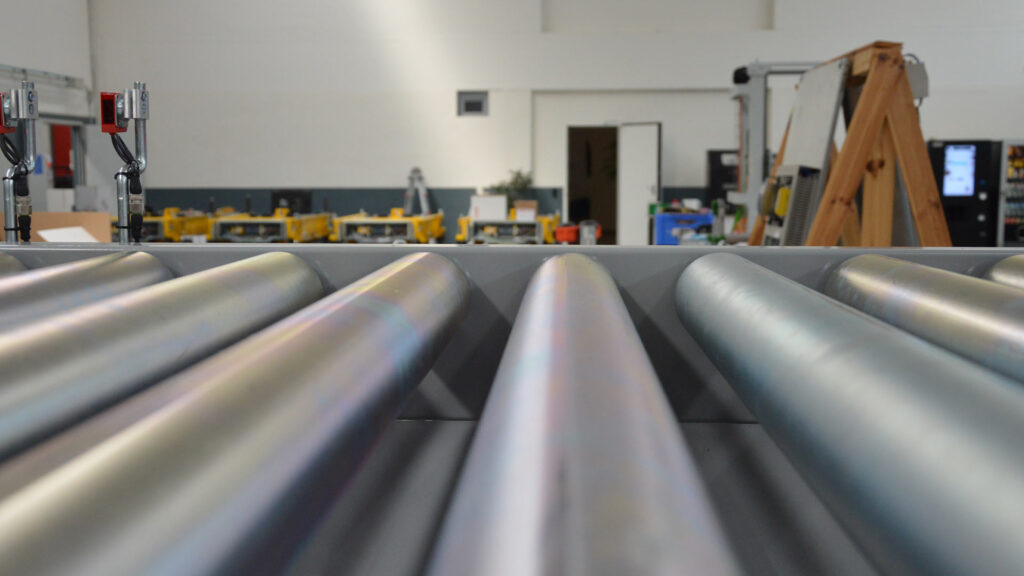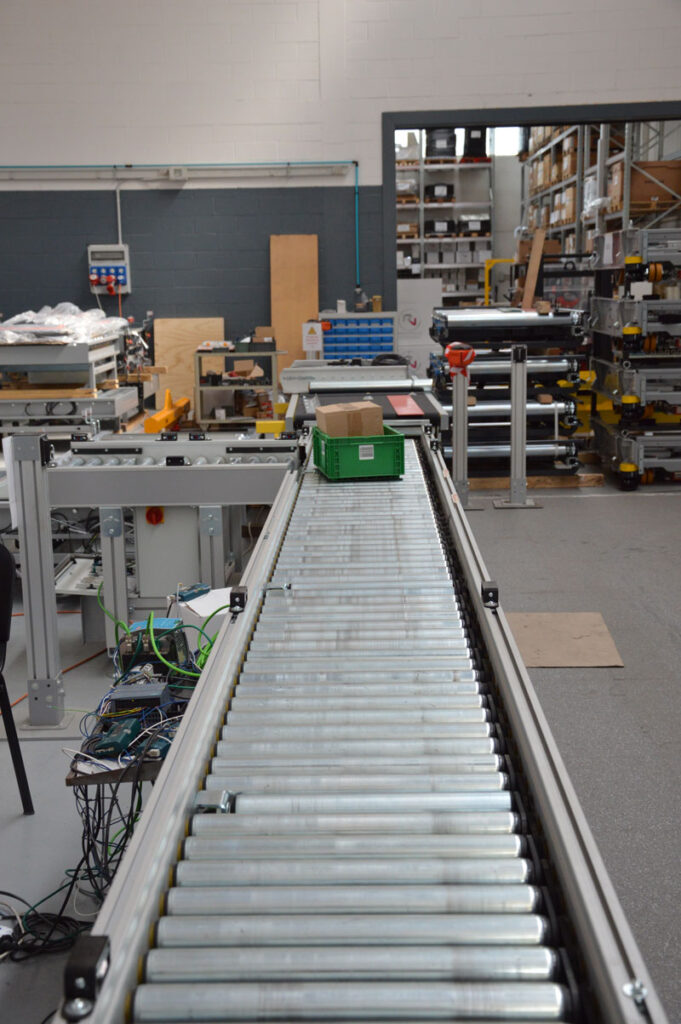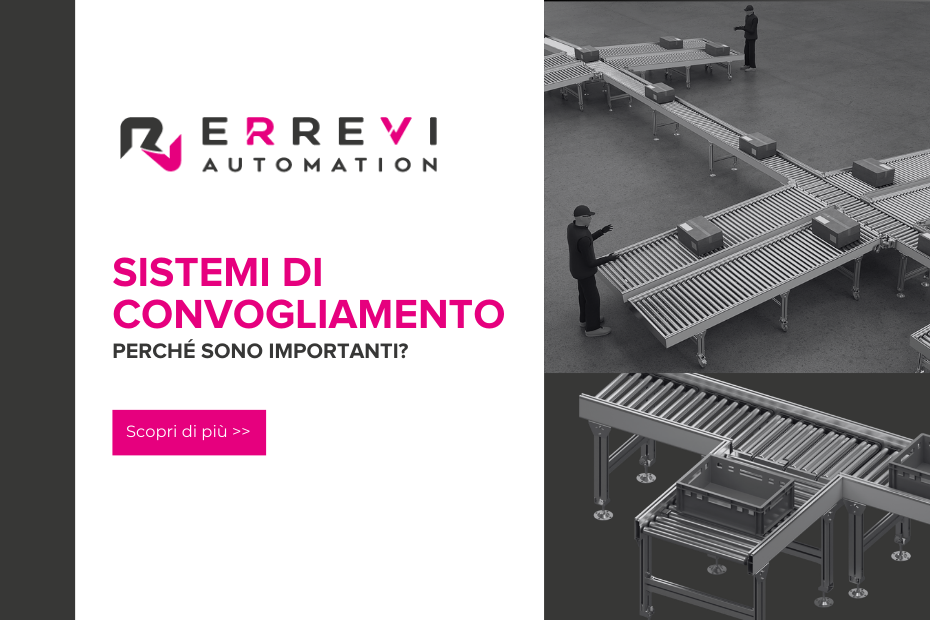Conveying systems are among the most commonly used automation solutions in almost all industrial sectors. In short, conveying systems include different types of equipment for the mechanical handling of materials. Their purpose is to handle a wide range of products. Warehouses around the world rely on them to facilitate logistics processes and ensure that they flow smoothly. In this article we will see why conveying systems are important.

In this article:
- What they are and why conveying systems are important
- Who invented the first conveying systems?
- How do the conveying systems work?
- What are the advantages of conveying systems?
What they are and why conveying systems are important
The conveyor systems most commonly used are conveyors with roller conveyors. These automatic handling systems allow you to transfer goods inside a warehouse, thanks to a battery of rollers developed to support loads and move them along a path.
in our previous articlewe compared WMS and WCS to brain and central nervous system respectively. Let's continue to follow the line of comparisons with the human body.
The conveying systems could be compared to the blood vessels. The work of the latter consists in facilitating an adequate supply of blood throughout the body, allowing it to function. Almost in the same way, well-designed conveying systems serve to facilitate inbound and outbound flows of pallets and containers in the areas of receipt and shipment of goods, allowing the automated warehouse to function properly.

Conveying systems have been used to handle different types and quantities of materials since the early 20th century. It is no exaggeration to label them as the backbone of material handling. They include:
- transport
- storage
- goods control through various production and distribution processes
Who invented the first conveying systems?
Hard to say. If there was only one inventor, unfortunately his name was lost in time. However, many people throughout history can claim some credit for helping the convoy systems evolve and become more efficient.
For example, the American manufacturer and inventor Thomas Robins in 1892 designed a conveyor system capable of transporting coal and oreMilling Company by Thomas Edison. His invention won first prize at the World Exhibition in Paris and continued to revolutionize the mining industry.
Another noteworthy pioneer in the history of conveying systems is none other than the famous car manufacturer Henry Ford. In 1913 he introduced the conveyor belt on the assembly line of the Michigan factory, continuously improving the technology. In this way, Ford has made conveying systems mainstream, increasing use and popularity.
Subscribe to our newsletter
How do the conveying systems work?
We said that conveyors with roller conveyors, the most used conveyor systems, work thanks to a battery of rollers that support and move loads. There are two types of rollers:
- Motorized rollers: are used by the action of a motor;
- Idle rollers: are used when roller conveyors use gravity and tilt to slide goods.
The main parts of conveyors with roller conveyors are:
- Support rollers: metal cylinders inserted in the construction with a metal axis at a regular distance from each other. Their purpose is to keep the roller conveyor taut and prevent the weight of the objects from creating dangerous bending points;
- Frame and legs: elements that form the construction on which the other parts are mounted, defining the shape and function of the conveyor belt and circuit trajectory;
- Curved roller conveyors: specific parts that allow to deviate the circuit, using the rotating tables or by adding chains at a certain point of the track (through which the trajectory of the pallet or container is diverted);
- Electrical parts: all electrical installations that allow the handling of loads through the path;
- Safety parts: mechanical instruments, photocells or detectors that allow the monitoring of the position of the loads and the communication of information to the control software.

What are the advantages of conveying systems?
Installing conveyor systems can be a great way to improve the efficiency of a warehouse. Whether handling packages, pallets or sorting, Errevi is able to meet the needs of your work with our solutions. Relying on Errevi’s conveying systems for material handling has the following advantages:
- High control levels: Installation of conveyor systems in the workplace allows for higher control levels. By reducing the possibility of human error, your new warehouse will give you a higher level of control.
- Adaptability: Conveying systems offer high levels of adaptability. Firstly, they are easily adaptable to a range of industries and functions, with a range of different types of systems. Secondly, the flexibility to adapt to different sizes and weights of products is a key factor for a warehouse;
- Reduces risks and injuries to the workforce: Eliminating risks in the workplace is very important. Facilitating the tasks of your employees by reducing the lifting and transport of potentially heavy goods and by the inconvenient form will provide your workplace with less risks than before.
We hope this article has helped you understand why conveying systems are important.
Errevi can provide you with a conveying system based on your needs. Contact us, an expert of our Sales Team will advise you on your next project!
Follow us on our social media channels
